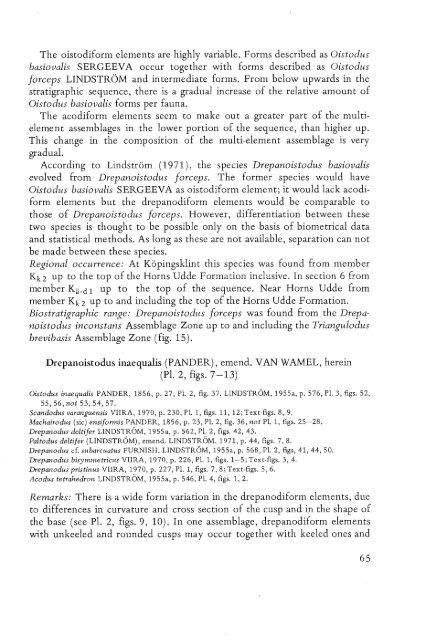UTRECHT MICROPALEONTOLOGICAL BUllETINS
UTRECHT MICROPALEONTOLOGICAL BUllETINS
UTRECHT MICROPALEONTOLOGICAL BUllETINS
You also want an ePaper? Increase the reach of your titles
YUMPU automatically turns print PDFs into web optimized ePapers that Google loves.
The oistodiform elements are highly variable. Forms described as Oistodus<br />
basiovalis SERGEEV A occur together with forms described as Oistodus<br />
forceps LINDSTROM and intermediate forms. From below upwards in the<br />
stratigraphic sequence, there is a gradual increase of the relative amount of<br />
Oistodus basiovalis forms per fauna.<br />
The acodiform elements seem to make out a greater part of the multielement<br />
assemblages in the lower portion of the sequence, than higher up.<br />
This change in the composition of the multi-element assemblage is very<br />
gradual.<br />
According to Lindstrom (1971), the species Drepanoistodus basiovalis<br />
evolved from Drepanoistodus forceps. The former species would have<br />
Oistodus basiovalis SERGEEVA as oistodiform element; it would lack acodiform<br />
elements but the drepanodiform elements would be comparable to<br />
those of Drepanoistodus forceps. However, differentiation between these<br />
two species is thought to be possible only on the basis of biometrical data<br />
and statistical methods. As long as these are not available, separation can not<br />
be made between these species.<br />
Regional occurrence: At Kopingsklint this species was found from member<br />
Kk 2 up to the top of the Horns Udde Formation inclusive. In section 6 from<br />
member Kii-d1 up to the top of the sequence. Near Horns Udde from<br />
member Kk 2 up to and including the top of the Horns Udde Formation.<br />
Biostratigraphic range: Drepanoistodus forceps was found from the Drepanoistodus<br />
inconstans Assemblage Zone up to and including the Triangulodus<br />
brevibasis Assemblage Zone (fig. 15).<br />
Drepanoistodus<br />
inaequalis (PANDER), emend. VAN WAMEL, herein<br />
(PI. 2, figs. 7-13)<br />
Oistodus inaequalis PANDER, 1856, p. 27, PI. 2, fig. 37. LINDSTROM, 1955a, p. 576, PI. 3, figs. 52,<br />
55,56,not53,54,57.<br />
Scandodus varanguensis VIIRA, 1970, p. 230, PI. 1, figs. 11,12; Text-figs. 8, 9.<br />
Machairodus (sic) ensiformis PANDER, 1856, p. 23, PI. 2, fig. 36, not PI. 1, figs. 25-28.<br />
Drepanodus deltifer LINDSTROM, 1955a, p. 562, PI. 2, figs. 42, 43.<br />
Paltodus deltifer (LINDSTROM), emend. LINDSTROM, 1971, p. 44, figs. 7,8.<br />
Drepanodus d. subarcuatus FURNISH. LINDSTROM, 1955a, p. 568, PI. 2, figs, 41, 44, 50.<br />
Drepanodus bisymmetricus VIIRA, 1970, p. 226, PI. 1, figs. 1-5; Text-figs. 3,4.<br />
Drepanodus pristinus VIIRA, 1970, p. 227, PI. 1, figs. 7,8; Text-figs. 5, 6.<br />
Acodus tetrahedron LINDSTROM, 1955a, p. 546, PI. 4, figs. 1,2.<br />
Remarks: There is a wide form variation in the drepanodiform elements, due<br />
to differences in curvature and cross section of the cusp and in the shape of<br />
the base (see PI. 2, figs. 9, 10). In one assemblage, drepanodiform elements<br />
with unkeeled and rounded cusps may occur together with keeled ones and
















